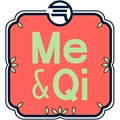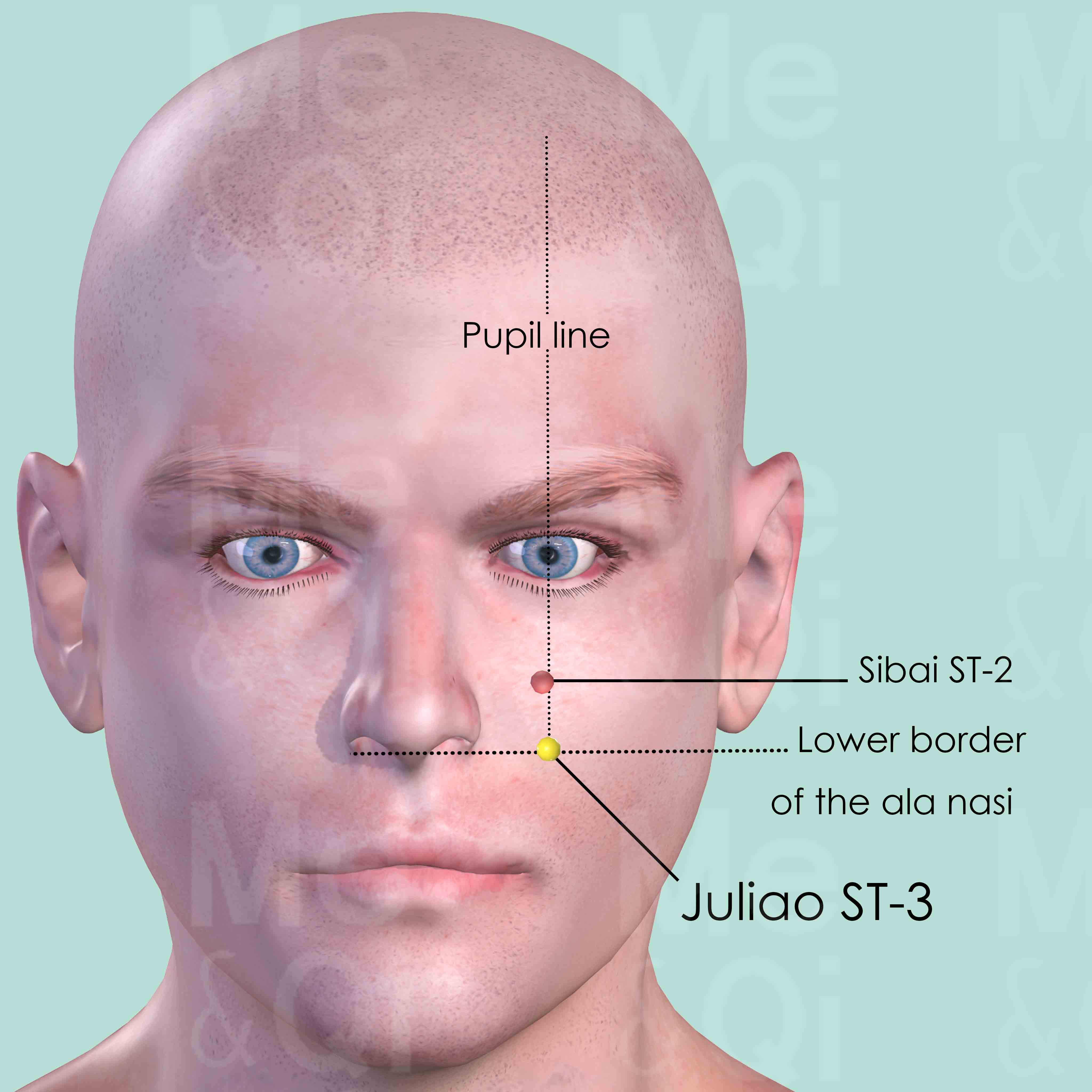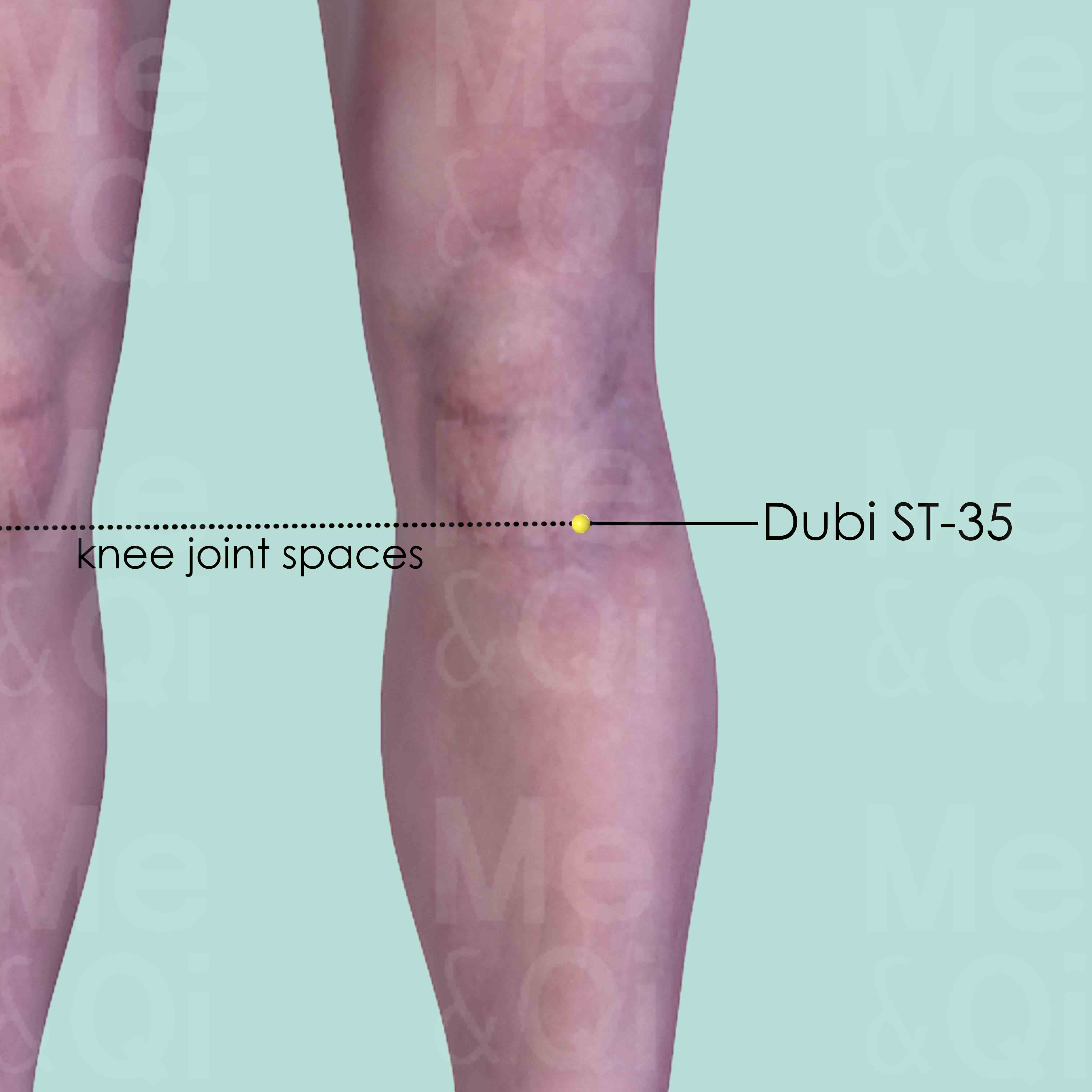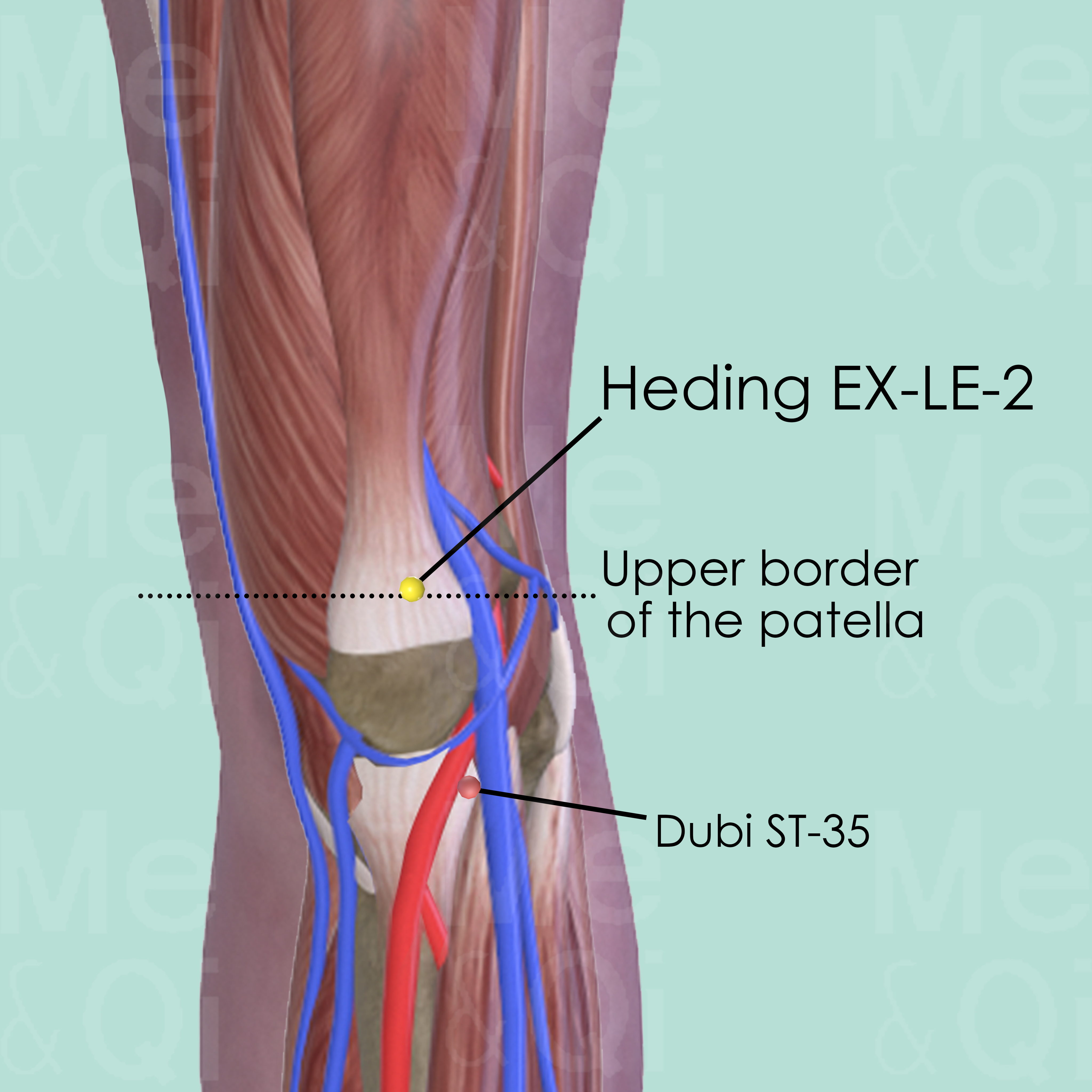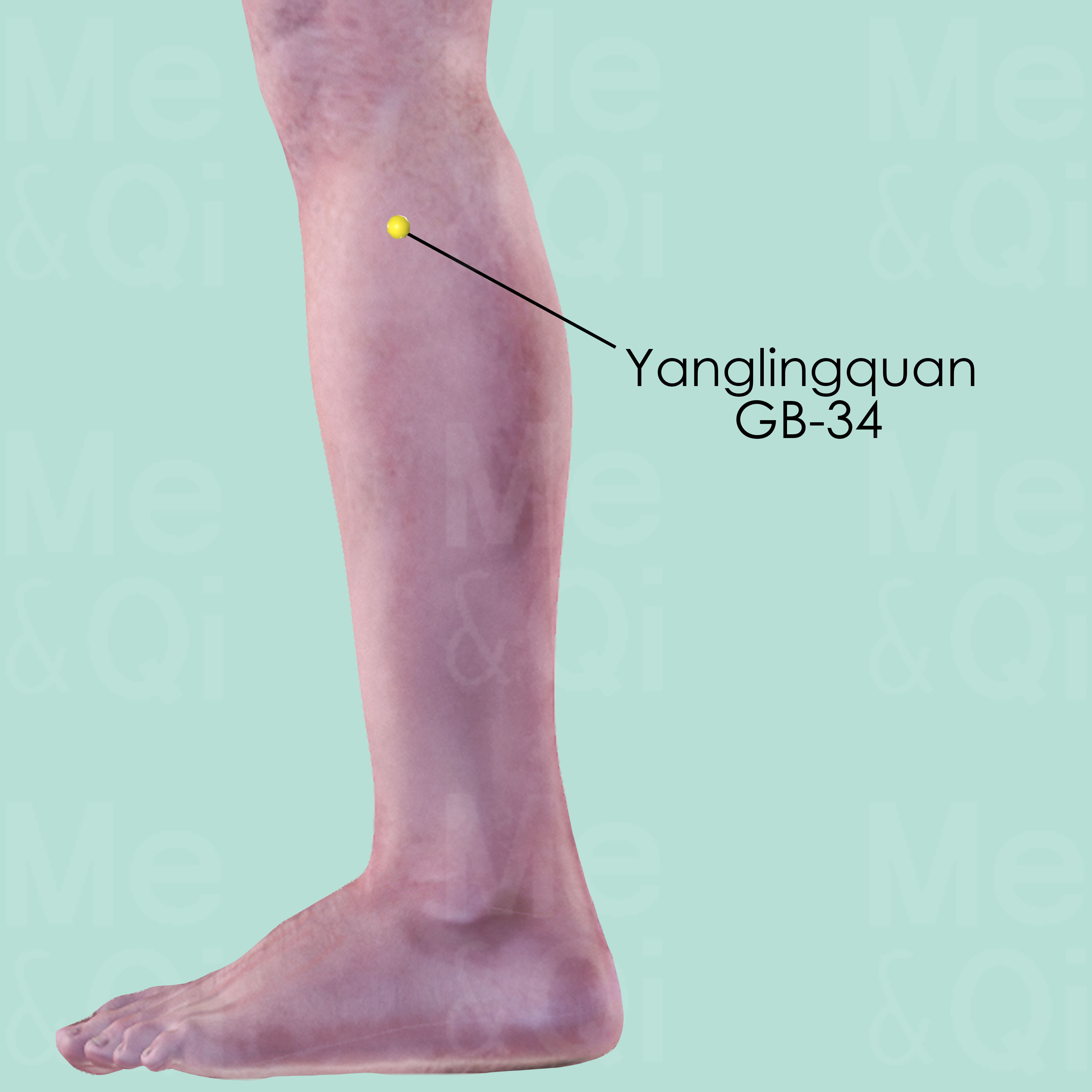Swollen Jointsaccording to TCM
What is Swollen Joints?
Swollen joints are a common symptom indicating inflammation or fluid accumulation within a joint, leading to its enlargement and often accompanied by pain, stiffness, and reduced mobility. This condition can affect any joint in the body but is most frequently observed in the knees.
It may result from various underlying causes, including injury, arthritis, or infections, significantly impacting one's quality of life. Understanding the specifics of swollen joints is crucial for effective diagnosis and treatment, highlighting the need for medical attention when this symptom is present.
How does TCM view Swollen Joints?
Traditional Chinese Medicine (TCM) offers a distinct perspective on swollen joints, diverging from the pathophysiological explanations commonly found in Western medicine. TCM interprets swollen joints as a manifestation of underlying imbalances or disharmonies within the body's energy system.
It emphasizes the importance of identifying the specific pattern of disharmony causing the symptom, as this determination guides the treatment strategy. According to TCM, swollen joints can result from a variety of patterns, each requiring a tailored therapeutic approach to restore balance and health.
Root Causes of Swollen Joints in TCM
In the TCM framework, swollen joints are often attributed to the invasion of external pathological factors like Dampness and Cold, disrupting the smooth flow of Qi and Blood through the Channels and muscles. For instance, Dampness invading the Channels can lead to symptoms such as joint stiffness, arthralgia, and a heavy sensation in the limbs, reflecting an accumulation that obstructs the body's energetic pathways.
Cold patterns, on the other hand, manifest through sharp, intense joint pain and stiffness, indicating the congealing effect of Cold on the body's meridians. These examples illustrate just a fraction of the possible causes in TCM, underscoring the complexity and individualized nature of diagnosing and treating swollen joints.
Explore below more details about what might cause Swollen joints according to TCM.
- By Syndrome
- Dampness
- Heat
- Cold
- Wind
- View More Causes
Dampness
"Dampness" in TCM is a concept that describes a pattern of disharmony where the body accumulates excess moisture. Imagine the heavy, sticky feeling you get on a very humid day; that's similar to what dampness feels like internally. It can manifest as a sense of heaviness, bloating, sluggishness, or even a foggy mind. This condition is often thought to arise from environmental factors like living in a damp place, dietary habits that promote moisture in the body, or internal imbalances that hinder the body's ability to process fluids properly. In TCM, dampness can obstruct the normal flow of energy and fluids in the body, leading to various symptoms.... see more
Dampness Patterns That Can Lead to Swollen Joints
Common Symptoms: Arthralgia Joint Stiffness Skin Numbness Heavy Joint Muscle Numbness Aversion To Cold Fever Neck Gland Swelling
| Pattern Name | Relevant Symptoms | Relevant Formulas |
|---|---|---|
| Dampness invading the Channels joints and muscles | Swollen joints, Arthralgia, Joint stiffness, Skin numbness, Heavy joint, Muscle numbness | Xiao Huo Luo Dan | Shu Jing Huo Xue Tang |
| Damp-Wind | Swollen joints, Aversion to cold, Fever, Neck gland swelling, Nausea, Perspiration, Occipital stiffness, Body pain, Muscle pain, Feeling of heaviness... see more | Qiang Huo Sheng Shi Tang | Jiu Wei Qiang Huo Tang | Cang Er Zi San | Xiao Feng San | Ku Shen Tang | Hai Tong Pi Tang |
| Damp-Heat in the Lower Burner | Red and swollen knees, Scanty and yellow urine, Lower back pain, Weakness of lower extremities, Red and swollen feet, Swollen knee, Thick greasy vaginal secretions, Ulcers on the lower limbs, Scanty and dark urine, Painful urination, Dry mouth... see more | Er Miao San |
Heat
In TCM "Heat" signifies an excess of Yang energy, leading to an imbalance where heat predominates over the body's cool Yin aspects. This condition is metaphorically akin to an internal over-heating. Symptoms indicative of Heat can include feelings of warmth, fever, sweating, irritability, red face, thirst with a preference for cold drinks, and a rapid pulse. The tongue may appear red with a yellow coating. Unlike the common interpretation of heat in terms of temperature, in TCM, it represents a state of hyperactivity or inflammation in the body.... see more
Heat Patterns That Can Lead to Swollen Joints
Common Symptoms: Arthralgia Joints Red And Hot Fever Thirst Anxiety Anemophobia Joint Stiffness Scanty And Yellow Urine
| Pattern Name | Relevant Symptoms | Relevant Formulas |
|---|---|---|
| Heat invading the Channels joints and muscles | Swollen joints, Arthralgia, Joints red and hot, Fever, Thirst, Anxiety, Anemophobia, Joint stiffness... see more | Xuan Bi Tang |
| Damp-Heat in the Lower Burner | Red and swollen knees, Scanty and yellow urine, Lower back pain, Weakness of lower extremities, Red and swollen feet, Swollen knee, Thick greasy vaginal secretions, Ulcers on the lower limbs, Scanty and dark urine, Painful urination, Dry mouth... see more | Er Miao San |
Cold
In TCM "Cold" as a pattern of disharmony refers to a specific type of imbalance within the body's systems, often linked to a deficiency or weakness. It's not about feeling physically cold or having a common cold, but rather a metaphorical description of certain symptoms and underlying conditions. When a TCM practitioner says someone suffers from "Cold," it usually implies that the body's Yang energy, which is warm and active, is insufficient or overpowered by Yin energy, which is cool and passive. Symptoms of Cold in TCM can include a general feeling of coldness, cold limbs, pale complexion, low energy, slow metabolism, and a preference for warmth. ... see more
Cold Patterns That Can Lead to Swollen Joints
| Pattern Name | Relevant Symptoms | Relevant Formulas |
|---|---|---|
| Cold invading the Channels joints and muscles | Swollen joints, Arthralgia, Joint stiffness, Muscle pain, Muscle numbness, Stiff neck | Wu Tou Tang | Xiao Huo Luo Dan |
Wind
In TCM "Wind" is a concept that represents a pattern of disharmony, often characterized by its sudden and unpredictable nature, much like a gusty wind changing direction without warning. This pattern is associated with symptoms that come and go quickly or move around the body, such as itching, tremors, or even certain types of pain. Wind is considered to be a primary cause of illnesses that have these rapidly changing characteristics. In TCM, external Wind often refers to illnesses that start suddenly, like the common cold, believed to be caused by external pathogenic factors like climatic changes. On the other hand, internal Wind can be linked to internal imbalances and can manifest in conditions like dizziness or spasms. ... see more
Wind Patterns That Can Lead to Swollen Joints
| Pattern Name | Relevant Symptoms | Relevant Formulas |
|---|---|---|
| Damp-Wind | Swollen joints, Aversion to cold, Fever, Neck gland swelling, Nausea, Perspiration, Occipital stiffness, Body pain, Muscle pain, Feeling of heaviness... see more | Qiang Huo Sheng Shi Tang | Jiu Wei Qiang Huo Tang | Cang Er Zi San | Xiao Feng San | Ku Shen Tang | Hai Tong Pi Tang |
TCM Herbal Formulas for Swollen Joints
To counteract the effects of patterns leading to swollen joints, TCM utilizes a variety of herbal formulas and specific herbs tailored to the identified disharmony. Formulas like Xiao Huo Luo Dan and Shu Jing Huo Xue Tang are recommended for cases characterized by Dampness and Blood Stagnation, aiming to warm the interior and dispel Cold, while invigorating Blood to alleviate arthralgia and stiffness.
In situations where Cold invades the channels, formulas such as Wu Tou Tang are employed to warm the meridians and disperse Cold, addressing the root causes of pain and swelling. These treatments highlight TCM's holistic approach, focusing on restoring harmony and balance to the body's energy system, rather than merely alleviating symptoms.
Explore below some TCM herbal formulas used to address swollen joints, organized by cause and by formula type.
- By Cause
- By Formula Type
- Dampness
- Heat
- Cold
- Wind
- View More Causes
- Formulas that dredge and disperse external wind
- Formulas that dispel wind-Damp
- External formulas for external disorders
- Formulas that warm the meridians and disperse cold
- Formulas that invigorate blood and dispel blood stagnation
- Formulas that clear wind-Cold
- Formulas that expel dampness
Top Formula for Dampness:
Xiao Huo Luo Dan
Suitable for Dampness patterns that may cause swollen joints, such as Dampness invading the Channels joints and muscles
Learn moreAll Formulas Recommended for Swollen Joints Caused by Dampness
| Formula | Patterns Suitable For |
|---|---|
| Xiao Huo Luo Dan | Dampness invading the Channels joints and muscles |
| Shu Jing Huo Xue Tang | Dampness invading the Channels joints and muscles |
| Qiang Huo Sheng Shi Tang | Damp-Wind |
| Jiu Wei Qiang Huo Tang | Damp-Wind |
| Cang Er Zi San | Damp-Wind |
| Xiao Feng San | Damp-Wind |
| Ku Shen Tang | Damp-Wind |
| Hai Tong Pi Tang | Damp-Wind |
| Er Miao San | Damp-Heat in the Lower Burner |
Top Formula for Heat:
Xuan Bi Tang
Suitable for Heat patterns that may cause swollen joints, such as Heat invading the Channels joints and muscles
Learn moreAll Formulas Recommended for Swollen Joints Caused by Heat
| Formula | Patterns Suitable For |
|---|---|
| Xuan Bi Tang | Heat invading the Channels joints and muscles |
| Er Miao San | Damp-Heat in the Lower Burner |
Top Formula for Cold:
Xiao Huo Luo Dan
Suitable for Cold patterns that may cause swollen joints, such as Cold invading the Channels joints and muscles
Learn moreAll Formulas Recommended for Swollen Joints Caused by Cold
| Formula | Patterns Suitable For |
|---|---|
| Xiao Huo Luo Dan | Cold invading the Channels joints and muscles |
| Wu Tou Tang | Cold invading the Channels joints and muscles |
Top Formula for Wind:
Qiang Huo Sheng Shi Tang
Suitable for Wind patterns that may cause swollen joints, such as Damp-Wind
Learn moreAll Formulas Recommended for Swollen Joints Caused by Wind
| Formula | Patterns Suitable For |
|---|---|
| Qiang Huo Sheng Shi Tang | Damp-Wind |
| Jiu Wei Qiang Huo Tang | Damp-Wind |
| Cang Er Zi San | Damp-Wind |
| Xiao Feng San | Damp-Wind |
| Ku Shen Tang | Damp-Wind |
| Hai Tong Pi Tang | Damp-Wind |
Formulas that dredge and disperse External Wind
These formulas are suitable for some swollen joints-causing patterns like Cold invading the Channels joints and muscles or Dampness invading the Channels joints and muscles.
One such formula is Xiao Huo Luo Dan, with prepared kusnezoffii aconite as a key herb.
Other formulas of this category are listed in the table below.
All "formulas that dredge and disperse external wind" recommended for swollen joints
| Formula | Patterns Suitable For (if applicable) |
|---|---|
| Xiao Huo Luo Dan | Cold invading the Channels joints and muscles, Dampness invading the Channels joints and muscles, Painful Obstruction... see more |
| Cang Er Zi San | Damp-Wind |
| Xiao Feng San | Damp-Wind |
Formulas that dispel Wind-Damp
These formulas are suitable for some swollen joints-causing patterns like Damp-Wind.
One such formula is Qiang Huo Sheng Shi Tang, with notopterygium root as a key herb.
Other formulas of this category are listed in the table below.
All "formulas that dispel wind-Damp" recommended for swollen joints
| Formula | Patterns Suitable For (if applicable) |
|---|---|
| Qiang Huo Sheng Shi Tang | Damp-Wind |
| Xuan Bi Tang | Heat invading the Channels joints and muscles |
| Da Fang Feng Tang | Painful Obstruction |
Formulas that warm the Meridians and disperse Cold
These formulas are suitable for some swollen joints-causing patterns like Cold invading the Channels joints and muscles or Painful Obstruction.
One such formula is Wu Tou Tang, with prepared sichuan aconite as a key herb.
External formulas for External disorders
These formulas are suitable for some swollen joints-causing patterns like Damp-Wind.
One such formula is Ku Shen Tang, with sophora root as a key herb.
Other formulas of this category are listed in the table below.
All "external formulas for external disorders" recommended for swollen joints
| Formula | Patterns Suitable For (if applicable) |
|---|---|
| Ku Shen Tang | Damp-Wind |
| Hai Tong Pi Tang | Damp-Wind |
Formulas that invigorate Blood and dispel Blood Stagnation
These formulas are suitable for some swollen joints-causing patterns like Dampness invading the Channels joints and muscles.
One such formula is Shu Jing Huo Xue Tang, with dong quai as a key herb.
Formulas that clear Wind-Cold
These formulas are suitable for some swollen joints-causing patterns like Damp-Wind.
One such formula is Jiu Wei Qiang Huo Tang, with notopterygium root as a key herb.
Formulas that expel Dampness
These formulas are suitable for some swollen joints-causing patterns like Damp-Heat in the Lower Burner.
One such formula is Er Miao San, with phellodendron bark as a key herb.
Acupoints for Swollen Joints
Explore below some acupoints used to address swollen joints, organized by meridian.
- By Meridian
- Stomach Channel
- Extra Points: Lower Extremities (EX-LE)
- Gall Bladder Channel
- Lung Channel
- Bladder Channel
- Spleen Channel

Liangqiu ST-34
2 cun above the upper-lateral border of the patella, on a line between the upper lateral patellar border and the anterior superior iliac spine (ASIS).
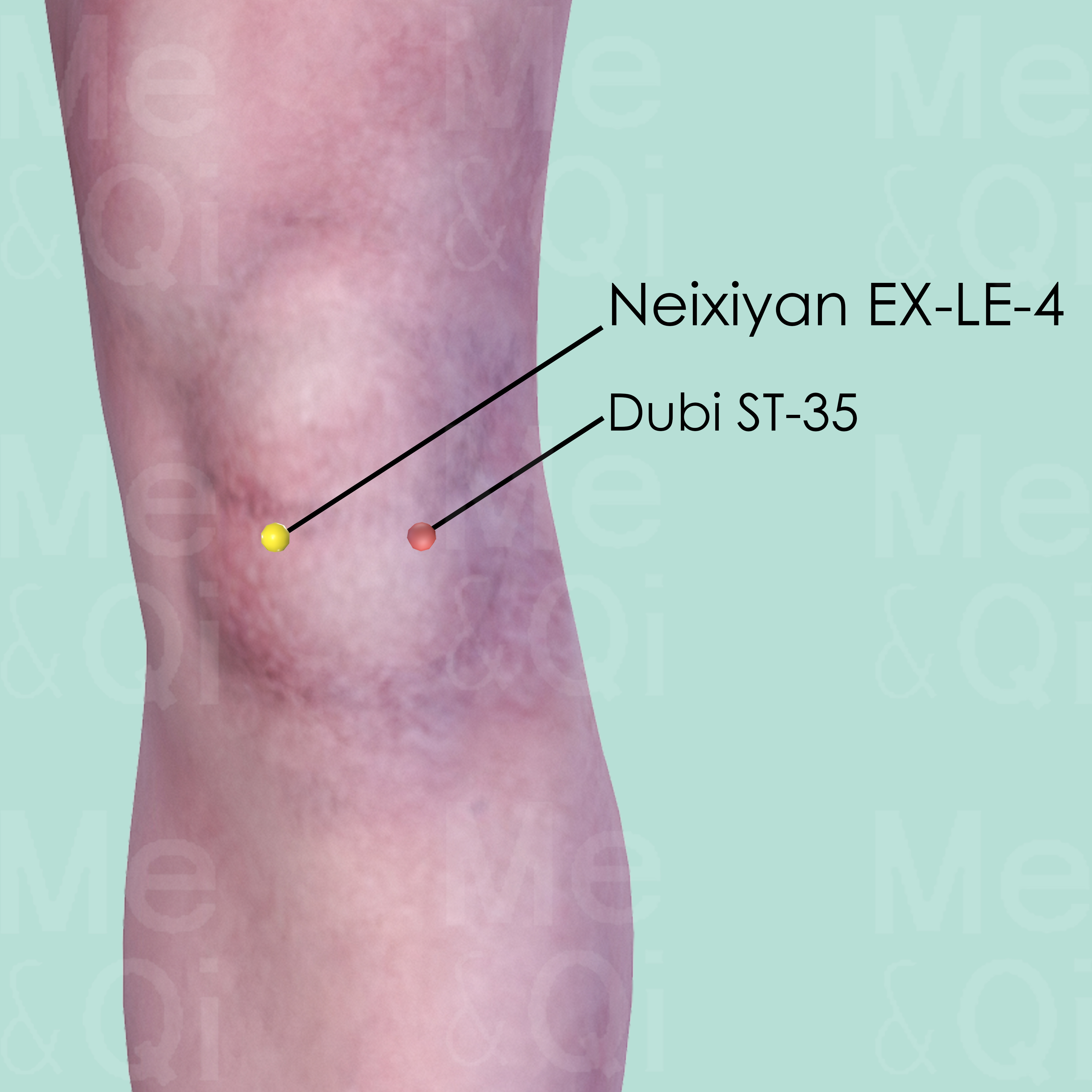
Neixiyan EX-LE-4
With the knee flexed, inferior to the patella, in a depression medial to the patellar ligament. Dubi ST-35 is at the same level, in a depression lateral to the patellar ligament. Both points form the Extra point of Xiyan EX-LE-5.
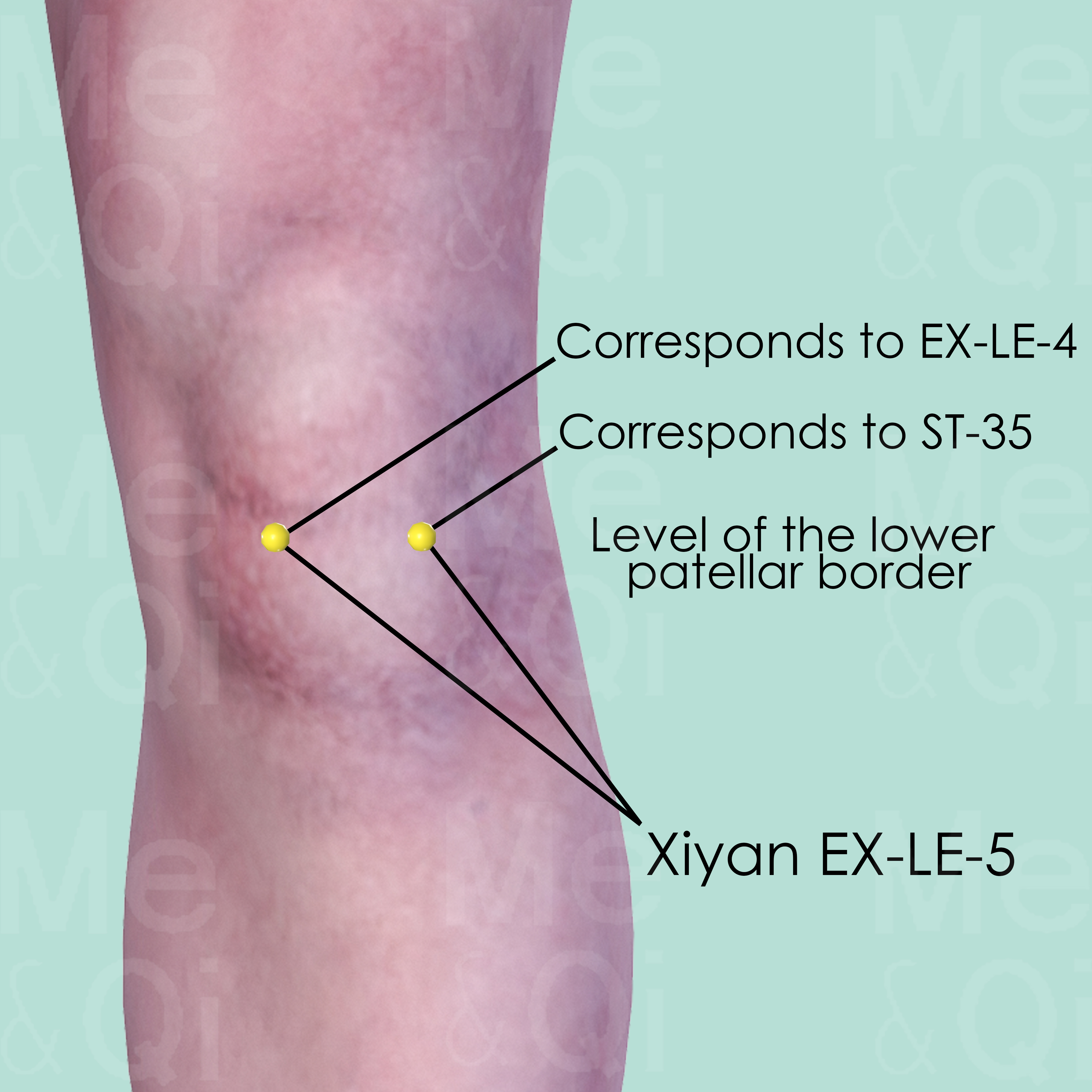
Xiyan EX-LE-5
This is a group of 2 points, composed of Dubi ST-35 and Neixiyan EX-LE-4. Both are located inferior to the patella, medial and lateral to the patellar ligament. Dubi ST-35 is the lateral one, while Neixiyan EX-LE-4 is the medial one.
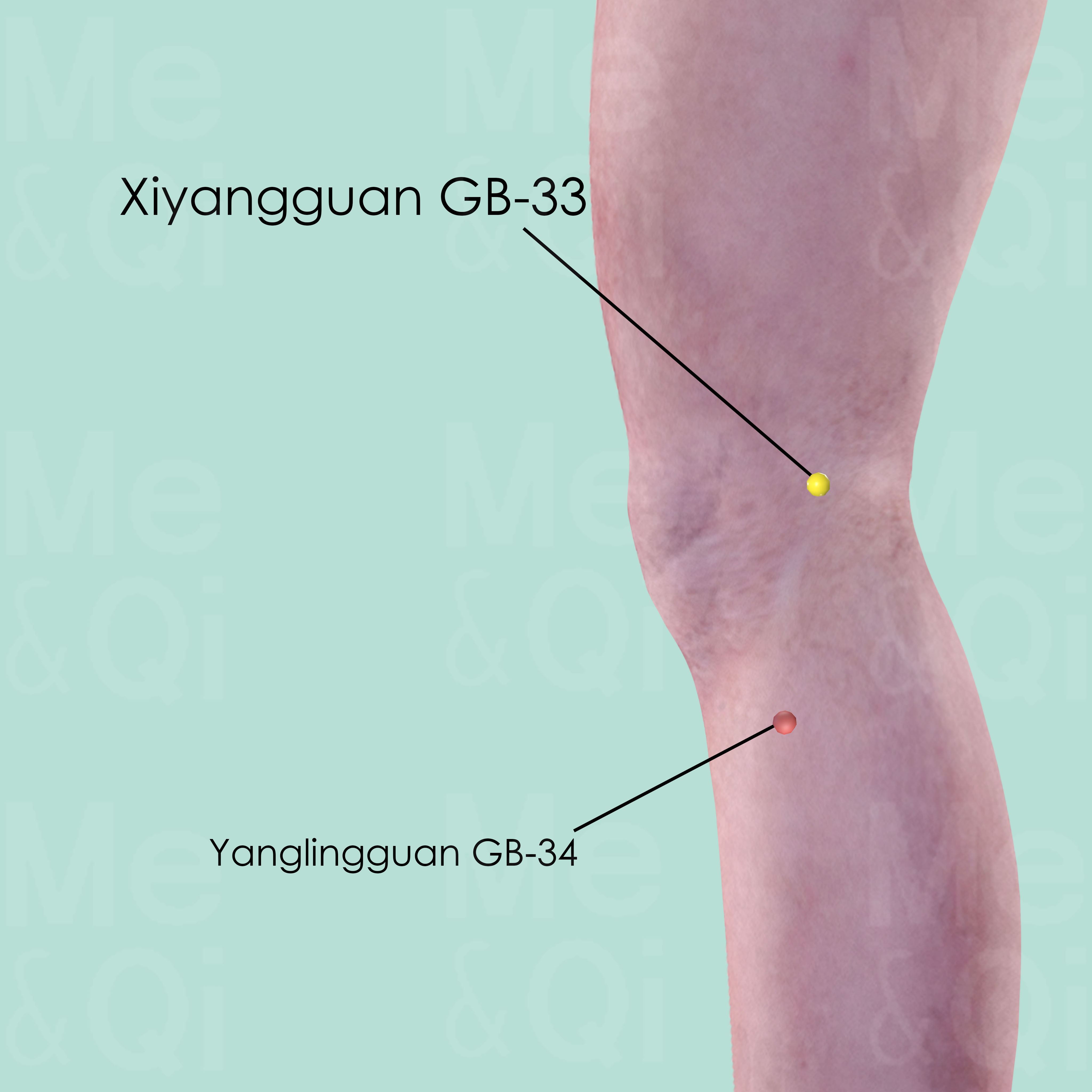
Xiyangguan GB-33
When the knee is flexed, Xiyangguan GB-33 is above Yanglingguan GB-34, in the depression between the shaft of the lateral epicondyle and the tendon of the biceps femoris muscle.
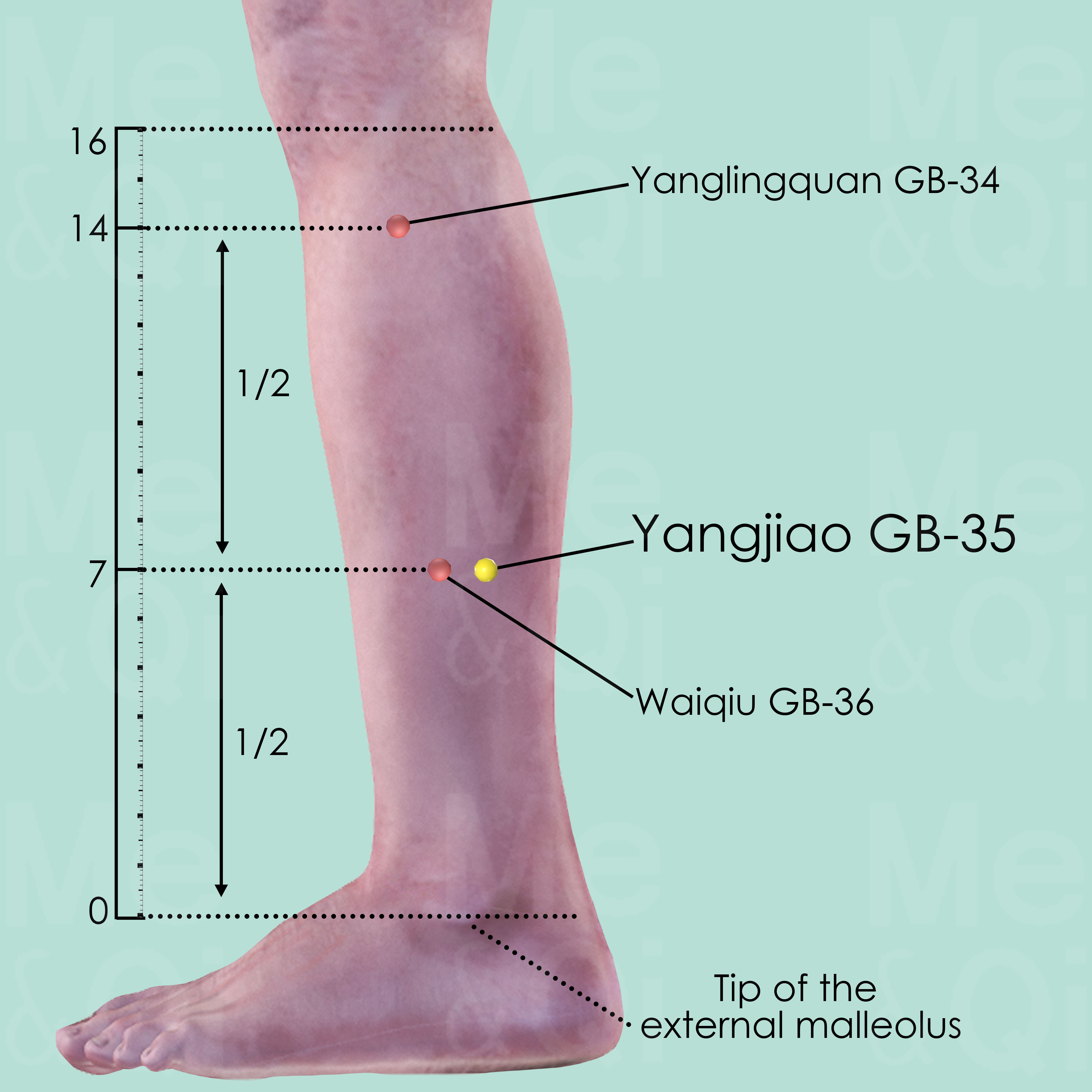
Yangjiao GB-35
7 cun above the tip of the external malleolus, on the posterior border of the fibula, within the distance between the tip of the external malleolus and Yanglingquan GB-34. It is also at the same level as Waiqiu GB-36.
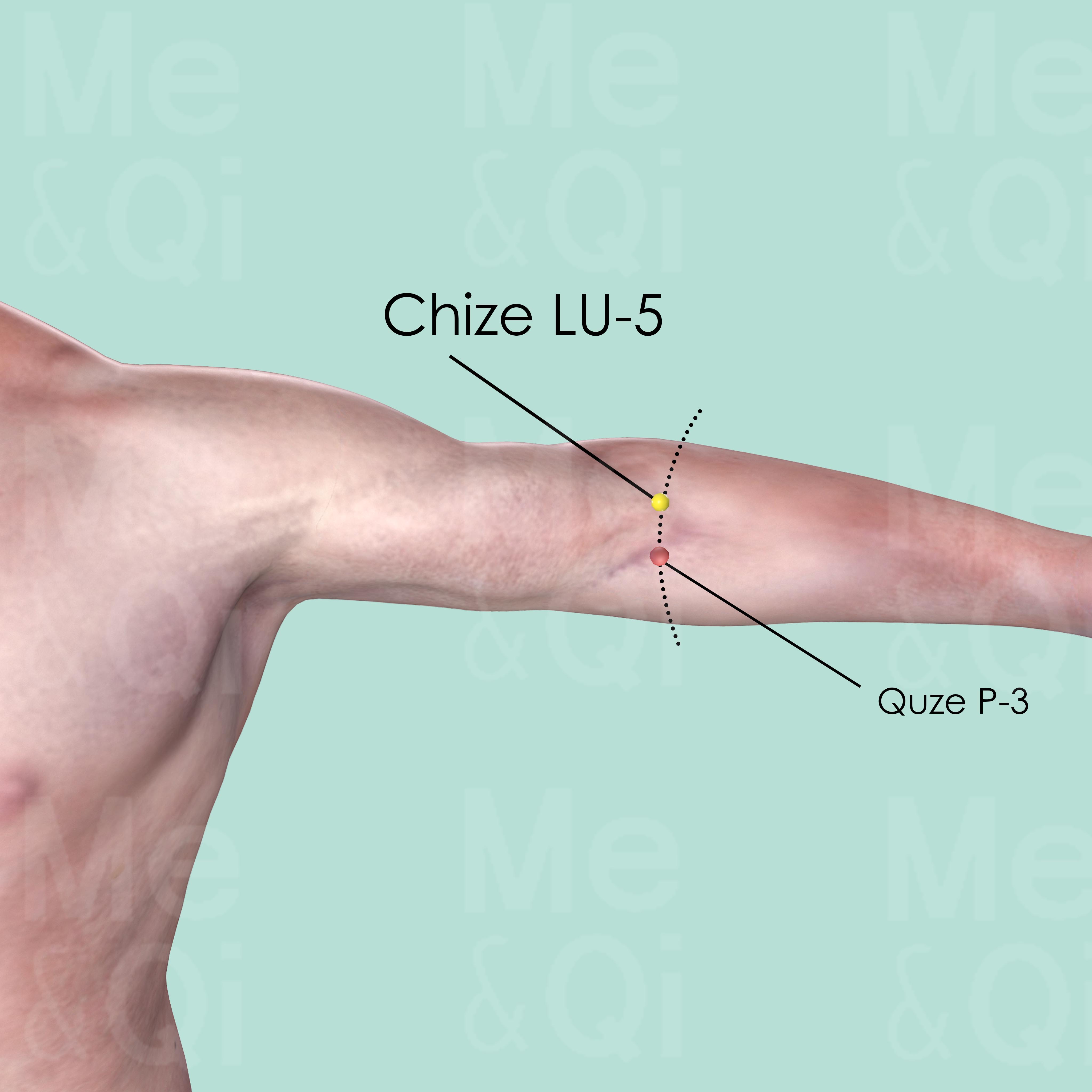
Chize LU-5
On the cubital crease, on the redial aspect of the biceps tendon. It can be easily identified when the elbow is slightly flexed.
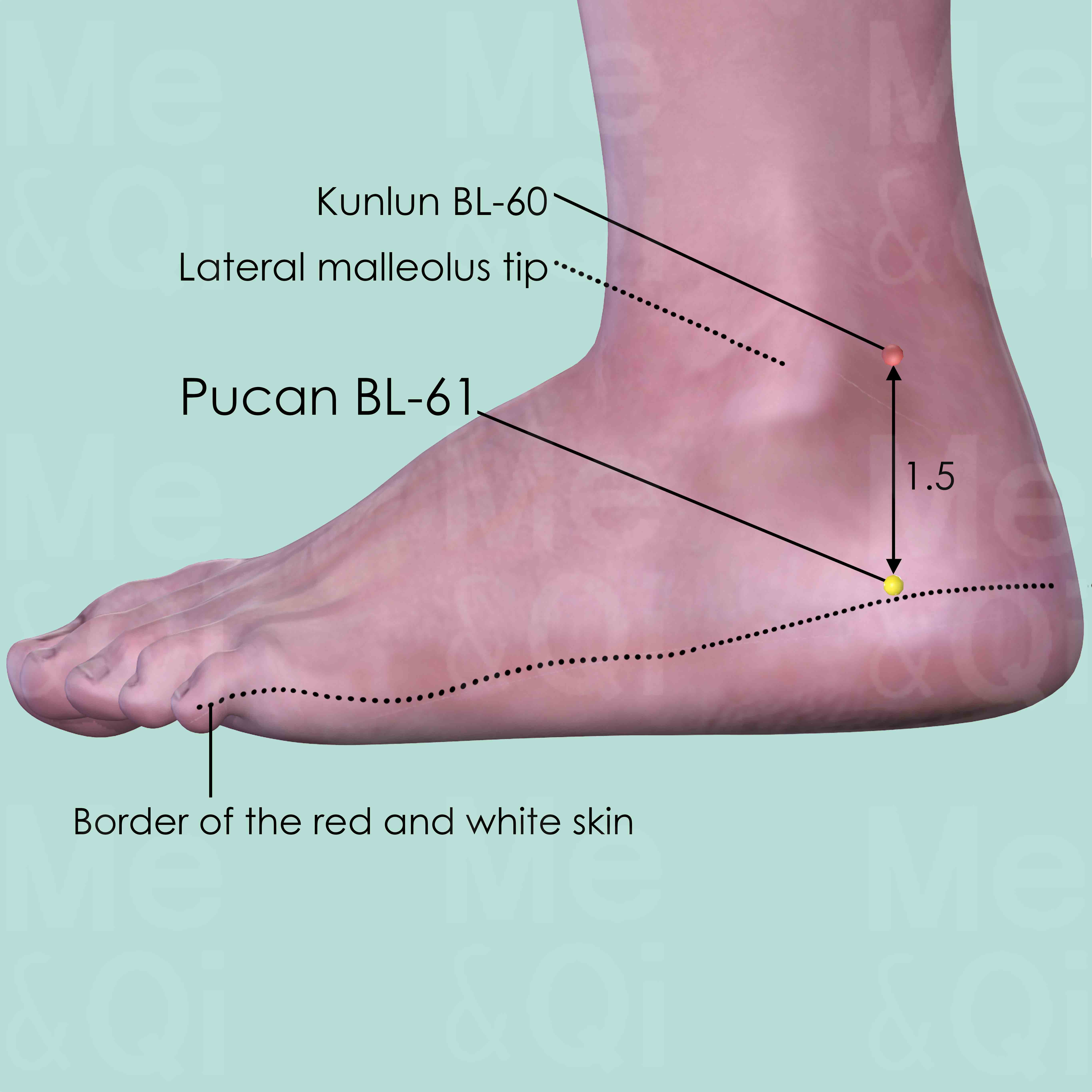
Pucan BL-61
Posterior and inferior to the external malleolus, directly below Kunlun BL-60, in the depression of the calcaneum at the junction of the red and white skin.
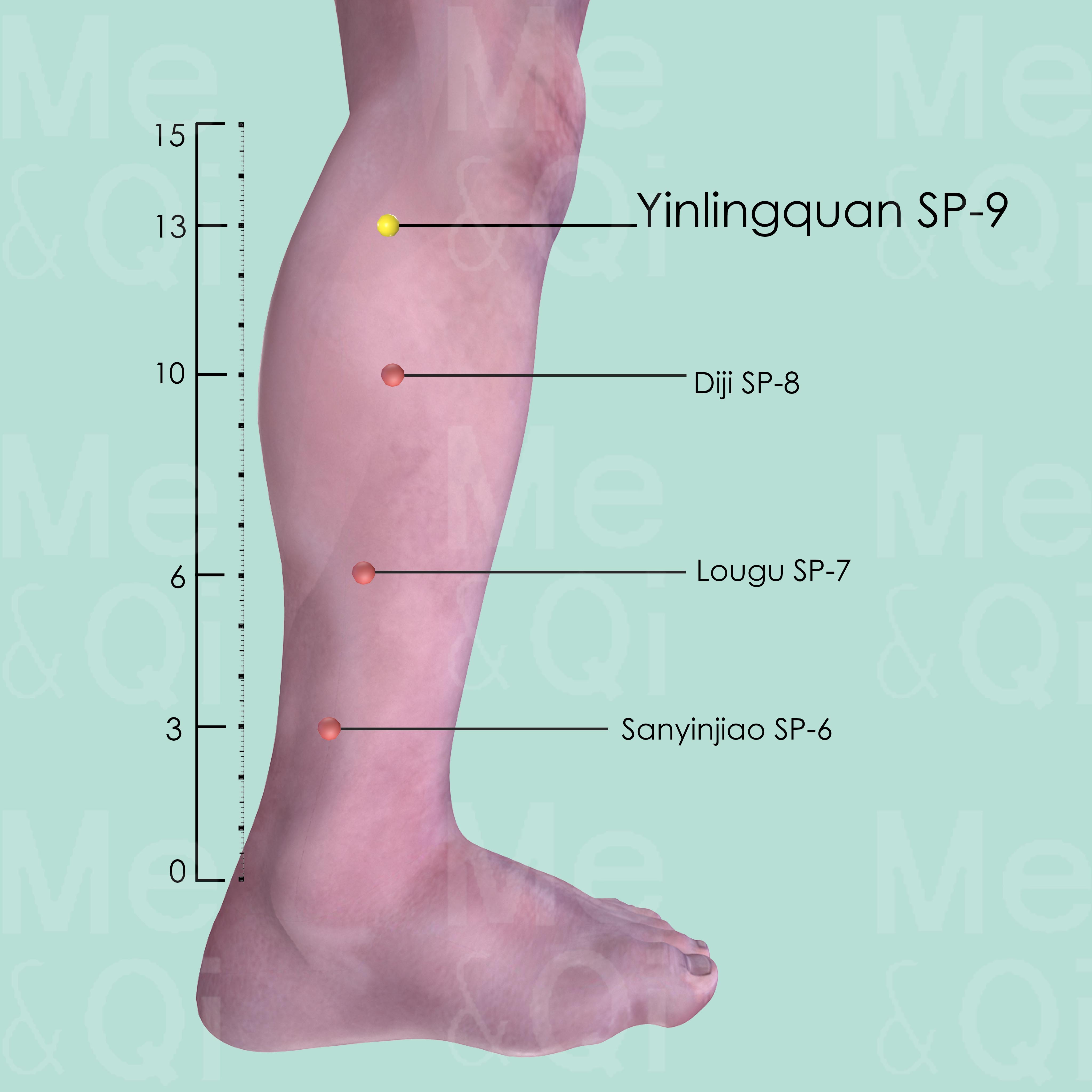
Yinlingquan SP-9
On the lower border of the medial condyle of the tibia, in the depression between the posterior border of the tibia and gastrocnemius muscle.
